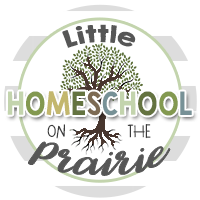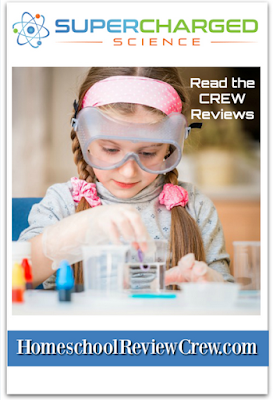May292019
May
29
2019
29 May 2019
Supercharged Science Review
May 29, 2019
e-Science Homeschool
Science Curriculum is great for secular and religious worldview as it doesn’t
focus on either point of view which makes it very neutral to teach whatever
your views are. This is an amazing hands-on science curriculum.
Before you get started I would recommend that you take advantage of the New Members Get Started video. Once you click on this section there are five videos. This will give you an overview of the how the website works. It will be a tremendous help so you don’t get overwhelmed with all the content that is on this website. Once you have watched the videos navigation will be a breeze. You can also download a PDF User guide to help you navigate the website.
There are a few different ways to use Supercharged Science one way is by topic and the other is by grade level.
There are several units available, a unit on Mathemagic, Award Winning Science Fair Projects, and Teaching Resources. Each of the units includes videos on the topic with step by step instructions on the experiments, and printable worksheets. The worksheets are a mixture of recording your information and extra information on the topic you are working on. Whether you choose to go by topic or grade level you will cover the units in some form as some of them overlap each other in content. There are 1,000+ videos and not to mention a plethora of experiments. The supplies vary needed for the experiments. The majority of them are simple items you can find around your house. For the more advanced grades you will want to get some appropriate supplies to complete the experiments.
You have one log in for your family and you will have access to the site.
Before you get started I would recommend that you take advantage of the New Members Get Started video. Once you click on this section there are five videos. This will give you an overview of the how the website works. It will be a tremendous help so you don’t get overwhelmed with all the content that is on this website. Once you have watched the videos navigation will be a breeze. You can also download a PDF User guide to help you navigate the website.
There are a few different ways to use Supercharged Science one way is by topic and the other is by grade level.
There are several units available, a unit on Mathemagic, Award Winning Science Fair Projects, and Teaching Resources. Each of the units includes videos on the topic with step by step instructions on the experiments, and printable worksheets. The worksheets are a mixture of recording your information and extra information on the topic you are working on. Whether you choose to go by topic or grade level you will cover the units in some form as some of them overlap each other in content. There are 1,000+ videos and not to mention a plethora of experiments. The supplies vary needed for the experiments. The majority of them are simple items you can find around your house. For the more advanced grades you will want to get some appropriate supplies to complete the experiments.
You have one log in for your family and you will have access to the site.
An overview of the topics you can choose from
If you decide to use this by topic the hardest part is deciding where to
start. Once you decide you click on the image. You will see a basic overview
about that topic that you can read. On the right side of the page are the
videos. You can also print out a downloadable list for the material you will
need for your topic. You could focus on
Electricity or Chemistry. I even did a search for entomology which is the study
of insects. I have a daughter who is obsessed with insects and I found several
videos to keep her happy.
An overview of the grade levels
If you choose to go by grade level you have levels K through 8th
level already laid out. If you have high school you just choose the Advanced Topics.
You will see a summary of what is covered in each grade level. The beauty of it
is that if you decide you want to go by topics you aren’t locked into a grade
level.
Some of the concepts you will see in multiple places in grades and topics if they relate to one another. Also another common thread throughout grades and levels is that each area will give you an overview of the subject. There is a downloadable shopping list for materials needed to complete the experiments. Each and every lesson has a video. I haven’t seen one that doesn’t have a video with what I have looked at.
There is even an area about putting together a Science Journal and a Science Report. It covers tips on how to record your data, references, and so many other helpful tips and tricks. This section has step by step instructions along with videos.
How did I use Supercharged Science?
The first thing I did was get logged in and get myself familiar with the site. Which nothing has changes since I used this several years ago. However I got a sneak peek at the new website that is coming soon. The new website got a cleaner facelift and is laid out with easier navigation in mind but all the content is the same.
Some of the concepts you will see in multiple places in grades and topics if they relate to one another. Also another common thread throughout grades and levels is that each area will give you an overview of the subject. There is a downloadable shopping list for materials needed to complete the experiments. Each and every lesson has a video. I haven’t seen one that doesn’t have a video with what I have looked at.
There is even an area about putting together a Science Journal and a Science Report. It covers tips on how to record your data, references, and so many other helpful tips and tricks. This section has step by step instructions along with videos.
How did I use Supercharged Science?
The first thing I did was get logged in and get myself familiar with the site. Which nothing has changes since I used this several years ago. However I got a sneak peek at the new website that is coming soon. The new website got a cleaner facelift and is laid out with easier navigation in mind but all the content is the same.
After I click on 7th grade I come to this page
I did the majority of this with my 7th grade son.
We decided to go by grade. For the 7th grade you can do Life
Science, Energy, and Physics of Light and Lasers. This last year my son’s
science main focus was life science. We used this as a review to enhance the
concepts he learned.
Overview of scientific concepts taught in 7th grade Life Science
When I go to 7th grade science it gives me an
overview of scientific concepts are taught. We read over this section together. We discussed what we already knew. Some areas that he didn't remember from our curriculum last year.
This is what your student should take away knowledge wise in 7th grade Life Science
It will also tell me what they should learn in the
labs. We read this section together. There is also an 11 page
evaluation package. You can see the link to hit to download it along with
getting a list of the material I need to complete all the experiments. I opened this up and noted the materials I may need.
Underneath the video are your printable worksheets and exercises
In each video you can download the Student Worksheets and
Exercises. The worksheets are usually found underneath the videos.
The 7th grade Life Science starts out with several videos on the microscope from parts to making slides and so on. My son didn't do all the microscope lessons as he knows about the microscope and the parts of it. He did however view a few of the lessons on the microscope.
He eventually ended up jumping around in other areas outside of the Life Science like the the energy and physics of light and lasers. He ventured out some by topics if something caught his attention.
He did a lot of experiments overall. Some of the videos he just watched. He learned a lot from the videos.
The 7th grade Life Science starts out with several videos on the microscope from parts to making slides and so on. My son didn't do all the microscope lessons as he knows about the microscope and the parts of it. He did however view a few of the lessons on the microscope.
He eventually ended up jumping around in other areas outside of the Life Science like the the energy and physics of light and lasers. He ventured out some by topics if something caught his attention.
He did a lot of experiments overall. Some of the videos he just watched. He learned a lot from the videos.
Here are a few experiments we did do.
We pulled out our microscope and went over the parts of a microscope
My son went over osmosis in a hands on way using a potato.
We first watched the video and then gathered up our supplies for the experiment.
My 16 year old daughter with special needs joined us for many of the experiments. My son sliced up the potatoes and they are both the same size. He put salt and water in one cup and the other cup is just water. We let the potato set for awhile. You can see the steps we did in the photos.
The potato in the water would crack but, the one in salt water swelled up and was like rubber and you could bend it without it cracking.
He created his own microscope using two magnifying glasses.
Using the two magnifying glasses he viewed money moving the magnifying glasses apart and at different angles. He even added light from a near by lamp to see if it enhanced the view.
He made his sister an insect aspirator so she can use it with her upcoming state entomology event coming up next month. It has already been put to use and it works.
After watching the video he cut out a hand using cardboard. He glued bendable straws onto the hand.
This project took him two days. He cut rubber bands and yarn. He then tied them together and laced them through the straws. This is to represent the ligaments and tendons in your hand.
When you pull on the strings at the bottom of the hand the hand should bend like your own hand does. My son was thrilled that it worked. The only thing he would do different with this experiment is the put a bit of glue in the knot to keep the rubber band and yarn from slipping. This was his favorite experiment that he did.
My daughter found this experiment as she remembered it from the first time we used Supercharged Science. We put Ivory soap in the microwave. She thought it smelled really bad.
After it cooled down she could pick it up and had fun exploring the mass of soap!
This was a last minute experiment since we had celery in our house. The cat ate the first experiment and we had to lock her up while the celery sat in the cups. She was ready to eat the second experiment too!
My son's thoughts, "This is a fun program to use with science." "The hardest part is choosing what to do." "The robot hand was amazing and I kept the parts to try and improve it later."
The creator Aurora Lipper is fun and engaging throughout the lessons. You
can tell that she is really passionate about science. Her science background
shines through with each lesson.
Social
Media Links:
Facebook: https://www.facebook.com/superchargedsci/
Twitter: https://twitter.com/aurora_lipper
Pinterest: https://www.pinterest.com/superchargedsci/supercharged-science/
YouTube: https://www.youtube.com/user/auroram42/videos
There are 65 of us who have been using Supercharged Science so, don’t forget to see what other have to say about it too by clicking on the banner below.
Facebook: https://www.facebook.com/superchargedsci/
Twitter: https://twitter.com/aurora_lipper
Pinterest: https://www.pinterest.com/superchargedsci/supercharged-science/
YouTube: https://www.youtube.com/user/auroram42/videos
There are 65 of us who have been using Supercharged Science so, don’t forget to see what other have to say about it too by clicking on the banner below.
Labels:TOS Crew Reviews
Subscribe to:
Post Comments
(Atom)


Search This Blog
Grab my button!

Followers
Powered by Blogger.
Homeschool Planet
HSP Free Offer Email for REVIEWERS
Popular Posts
-
Disclaimer: I received a FREE copy of this product through the HOMESCHOOL REVIEW CREW in exchange for my honest review. I was not required t...
-
We are learning about the Viking in our history studies. What better way the enhance the learning by adding a craft to the mix. With my kid...
-
This is a post that I did back in 2009. I have put the Lapbook on my 4share for others to use. This is the first time I have put one of my...
-
About the Book Book: Capture the Moment Author: Suzanne Woods Fisher Genre: Contemporary Romance Release date: May 6, 2025 Kate Cunn...
-
We are at the second letter in the alphabet. I must confess that for this letter my first thought was…. B is for Bee. I...
Labels
20p12.1
4-H
About Me
American History
Ancient History
Autism
Beekeeping
Beekeeping 101
Bible
Blog Hop
Blogging
book
Book reviews
Camera Shots
Classroom
Coding
Curriculum
Disclosure Policy
Egypt
Entomology
Experiments
Family
Feast of Tabernacles
Field Trips
Free Printables
Garden
Geography
Giveaway
Giveaways
Hanukkah
Health
Hebrew
High School
History
homemade
Homemade Bread
Homemaking
homeschool
Homeschool crafts
Homeschooling
Honey Products for Sale
Honey Recipes
Horse Therapy
iPad & Apps
Israel
Just For Fun
Juvenile Arthritis
Kids
Lapbooks
Life Cycle
Life in general
Math
Medieval History
My kid said...
Organizing
Organizing/homeschooling
Our curriculum
Our Week Through the Lenses of a Camera
Passover
Photography
Prayer
Purim
Random Pictures from my Kids
Recipes
Review
Review Policy
Reviews
Rosh Hashanah
Science
Scripture
Sensory Processing Disorder
Shabbat
Shavout
Simchat Torah
Sonlight
Special Needs
Special Needs High School
Special Needs Product Reviews
STEAM
STEM
Stuff
Tish B’Av
tos
TOS Crew Reviews
Tu Bishvat
Viking History
Week in Review
Wordless Wednesday
Workboxes
Yom Ha'atzmaut
Yom Hashoah
Yom Hazikaron
Yom Kippur


















































0 comments:
Post a Comment
Thank you for visiting my blog.